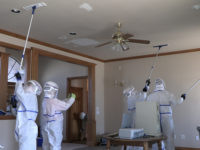Fact: Infectious diseases have killed more people than all the wars in history combined. Infectious diseases have been the scourge of humanity since the advent of civilization.
- Fact: C. diff (Clostridium Difficile Colitis) has killed more people than Ebola and can live outside the body for 70 to 90 days.
- Fact: Ebola virus has been found in bodily fluids 500 days after the patient was considered safe.
- Fact: Tuberculosis is one of the fastest growing communicable diseases in the world.
- Fact: At any given time, 20% of the population has staph. It is usually transmitted after contact with the eyes, nose, and throat triangle.
Did that get your attention? Good!
Say the words Forensic Restoration® and immediately someone will say, “Oh, like crime scene cleaning?” While crime and trauma scene cleaning and restoration are important parts of forensic restoration, as my grandmother used to say, “It takes a lot more than apples to make a good apple pie.”
Hoarding/unsanitary dwelling clean up, drug lab, animal fecal matter, acts of terrorism, bio-terrorism, and yes, infectious disease control and management, are part of the forensic restoration pie.
This article will in no way be able to begin to answer all the questions you might have regarding proper infectious disease control and management protocols. It is meant to raise your awareness, and instill a healthy respect and fear of your enemy. A boxing trainer told me many years ago that no one trains harder than a scared fighter.
Rocky Balboa asked a young fighter, “Hey, back home, who was your best friend?”
The young boxer just shrugged and said, “I don’t know.”
“I’ll tell you who it was. His name was Franky Fear,” said Balboa. “Franky Fear made you get up early to do roadwork, he made you go to the gym and train hard, he pushed you.”
As a forensic operator, you would be well advised to make friends with Franky Fear. Franky Fear will push you to learn more, train harder, check your equipment, and check yours and your teammates’ PPE before entering an infectious disease operational zone for cleaning and disinfecting. The last word you ever want to hear or utter on any forensic restoration project, but especially an infectious disease site, is “Oops!”
If you were to Google “infectious disease” right now, you would find a list of 217 infectious diseases including the common cold and strep throat. Life is full of possibilities and probabilities, so while there is a possibility as a Forensic Operator that you could get a call for the common cold, the probability of such a call is pretty low.
Rather than even try to run down the list of all 217 infectious diseases, I am going to specifically choose one to show how it is related to forensic restoration: C. diff. Clostridium Difficile Colitis is highly contagious and can live a long period of time on surfaces. It forms heat resistant spores that are hardy and tougher to kill than enveloped or non-enveloped viruses. So, make sure that your disinfecting agent of choice is EPA-approved and is rated on the label to be effective against C. diff.
According to the CDC, 20% of all C. diff infections are community-associated, meaning you can become infected through touch, from contact with contaminated objects or surfaces like cell phones, shopping cart handles, gym equipment, etc. If you touch a contaminated surface and then eat without washing your hands, you can ingest the bacteria and become sick.
Note: Alcohol-based hand sanitizers are not effective against C. diff spores.
People who become infected with C. diff can develop severe diarrhea and discharge large amounts of fecal matter which can contain blood and OPIM. The fecal matter associated with C. diff should be considered highly contagious and dangerous if left untreated. The Centers for Disease Control & Prevention (CDC) in its 2011 study showed 453,000 cases of C. diff per year, with 29,300 associated deaths. Every warrior wants a good death. This isn’t one. So, what are you going to do as a forensic operator when you get that call?
Almost every forensic restoration project begins the same, with a phone call. Here is where the acquisition of “critical incident data” begins. Who, what, where, when, and how are all very important pieces of information and if you’ll notice, those are the same questions that detectives such as Sherlock Holmes ask on every case: who, what, when, where, how, and why.
In our world, we leave off and don’t ask the “why” question. The why’s of the forensic world are better left to law enforcement and the judicial system.
After critical incident data is acquired, the next step is an actual forensic site assessment. After donning the proper PPE, it is here that the team can start to come up with a battle plan, take pictures, and make notes of all variables. It is at this time that an initial risk level gets assigned to the project. Note: All incident sites containing a known infectious agent should be performed at a risk level 4 per the RIA Forensic Guidelines.
The forensic restoration project for C. diff remediation can be broken down into three major categories:
- The acquisition of critical incident data
- Forensic site assessment
- Operations (to include: post ops and debriefing)
Training
Students learn, warriors train, and have no doubt in your mind, this is microbial warfare! Amateurs train until they get it right, professionals train until they get it wrong, so they can fix any holes in their systems while training rather than out in the field. I am going to lay down a training scenario for you. Run through this in your mind, which is your primary weapon. Ready?
Critical Incident Data
- Call came in early this morning from a woman who was taking care of her father.
- Father had hip replacement surgery and had returned home after nearly a week in the hospital.
- Loose stools turned into bloody, explosive diarrhea.
- She’s a nurse and has seen incidents of Clostridium difficile before. She’s afraid it’s C. diff and needs your help getting it cleaned up.
Site Assessment
- Bloody stools are in the master bathroom, primarily on the floor with some splatter in and around the toilet and on the walls.
- Bathroom floor is vinyl sheet. Walls are painted with semi-gloss paint with wood molding.
- The father was staying in the master bedroom and started having diarrhea while in bed.
- The daughter (nurse) washed the sheets and used sanitizing wipes to clean up the bed frame.
- Drops of bloody stool on the carpet were cleaned with sanitizing wipes.
- No one else has gotten diarrhea.
- She has an infant and a toddler who has asthma.
- The father’s dog is staying in the garage, but is periodically brought into his room to cheer him up.
Operation
Based on the risk level you assign, describe the engineering controls you would use:
- What zones will you set up? (Operation, Transition, Clear)
- What areas of the house will be in each zone?
- What will you use to separate the zones?
- How many operators will work this project?
- What PPE will your people wear?
- Where and how will they doff their PPE?
- How will they handle the waste that’s generated?
- What other engineering controls would you put in place?
How did you do? Did you use the template for forensic restoration during operations? Did you have questions along the way? Great! That’s why we train!
If you found your last training program failed to address infectious diseases enough to give you the tools you need, I would suggest that you seek out a training program that specifically addresses not only C. diff (and other infectious diseases), but also risk levels 1 thru 4.
If you are going to pursue a career in forensic restoration, I would strongly recommend that you contact the Global Biorisk Advisory Council.
Train hard, work safe, Walk in Beauty (Navajo Blessing)





Report Abusive Comment